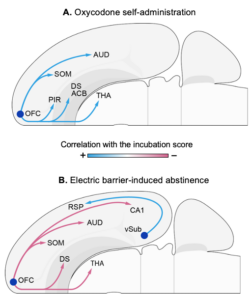
Reviews To Read – April 2024.
Published in Current Opinion in Neurobiology by Kenichiro Negishi and Yavin Shaham of the NIDA IRP Neurobiology of Relapse Section.
In this review we introduce the electric barrier conflict model of drug relapse and review studies on behavioral and neuropharmacological mechanisms of cue-induced relapse and incubation of drug seeking (time-dependent increase in drug seeking during abstinence) after electric barrier-induced voluntary abstinence. We also briefly discuss future directions and potential clinical implications. One major conclusion of our review is that the brain mechanisms controlling drug relapse after electrical barrier-induced voluntary abstinence are likely distinct from those controlling relapse after homecage forced abstinence.
Relapse after electric barrier-induced voluntary abstinence: A review Journal Article
In: Curr Opin Neurobiol, vol. 86, pp. 102856, 2024, ISSN: 1873-6882.
